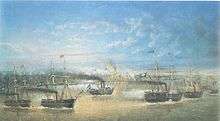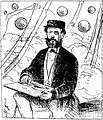Battle of Paso de Cuevas
The Battle of Paso de Cuevas was fought on 12 August 1865 during the Paraguayan invasion of the Argentine province of Corrientes.
| Battle of Paso de Cuevas | |||||||
|---|---|---|---|---|---|---|---|
| Part of the Paraguayan War | |||||||
 Battle of Cuevas after the Battle of Riachuelo, 12 August 1865 (José Murature). | |||||||
| |||||||
| Belligerents | |||||||
|
Argentina |
Paraguay | ||||||
| Commanders and leaders | |||||||
|
José Murature Francisco Manuel Barroso da Silva | José María Bruguez | ||||||
| Strength | |||||||
|
|
3,000 soldiers 34 cannons | ||||||
| Casualties and losses | |||||||
| 24 killed, 42 wounded | unknown | ||||||
Following losses after the Battle of Riachuelo, and running the gauntlet set up by Bruguez at Bella Vista in the Battle of Paso de Mercedes the day before, the allied fleet advanced down the River Parana, not wanting to be cut off from its supply base.[1]:36 However, the pass at Cuevas was once again manned by 3000 of Bruguez's men with 34 guns. Barroso suffered 24 dead and 42 wounded.[2]:779
This was the last operation of naval combat Argentine Navy at war with foreign nations to the Falklands War.
References
- Hooker, T.D., 2008, The Paraguayan War, Nottingham: Foundry Books, ISBN 1901543153
- Jaques, T., 2007, Dictionary of Battles and Sieges:P-Z, Westport: Greenwood Press, ISBN 978-0-313-33536-5
Further reading
- Theotonio Meirelles Da Silva, Historia Naval Brazileira, BiblioBazaar, LLC, 2008.
External links
| Wikimedia Commons has media related to Passagem de Cuevas. |
Gallery
 A. L. von Hoonholtz, commander of the gunboat Araguary, passing the battery of Cuevas and drawing it.
A. L. von Hoonholtz, commander of the gunboat Araguary, passing the battery of Cuevas and drawing it. The 1st Lt. Fortunato Foster Vidal, secretary of the Captain at sea Alvim, seeing the helm of the corvette Reberibe unusable by a bullet of paraguayas batteries, run to repair the damage; and under live fire, gives direction to the ship.
The 1st Lt. Fortunato Foster Vidal, secretary of the Captain at sea Alvim, seeing the helm of the corvette Reberibe unusable by a bullet of paraguayas batteries, run to repair the damage; and under live fire, gives direction to the ship..jpg) Plan of the passage of the Brazilian Squadron by the ravines of Turupi and Guabijú, in 12 August 1865. Raised and drawn by A. L. von Hoonholtz (Suplemento da Semana Illustrada n.º 248, 1865).
Plan of the passage of the Brazilian Squadron by the ravines of Turupi and Guabijú, in 12 August 1865. Raised and drawn by A. L. von Hoonholtz (Suplemento da Semana Illustrada n.º 248, 1865).
This article is issued from Wikipedia. The text is licensed under Creative Commons - Attribution - Sharealike. Additional terms may apply for the media files.